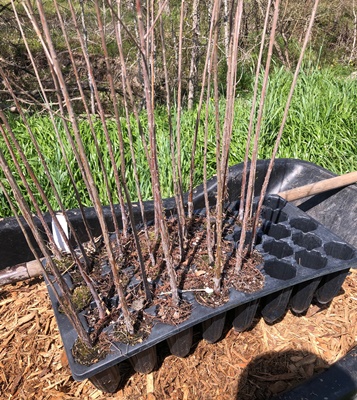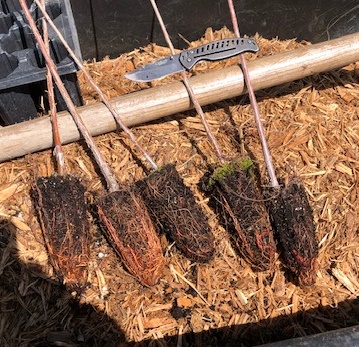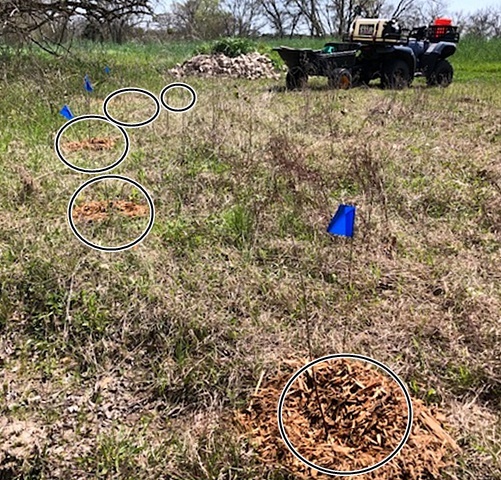| This is my tree planting outfit. It's a Honda Foreman ATV pulling a utility trailer. On the trailer is mulch, a shovel, the trees and fertlizer. On the ATV is a water tank, a bucket with the drill, various size auger bits and flags. |
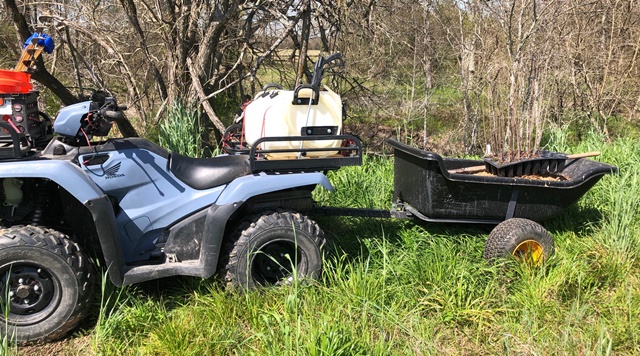
|
|
Another view of the tree planting setup. In the trailer is mulch, a shovel, the trees, a bag of MicroLife fertlizer. On the back of the ATV is a 30 gallon water tank with a pump and spray wand. |

|
Options to make a hole to put the tree seedlings in. The choices are a dibble bar (the orange bar) or auger bits.
- Dibble Bar: this is the classic way to plant pine trees. I did not like them - while it may work for bare root seedlings, the hole it opens does not work well for seedlings with plug roots. It can mash the root, hole may not be the right shape, and tree may not be vertical.
- Auger bits: these open a hole the perfect size for the root plugs. You need a couple of different sizes for different size root balls.
|
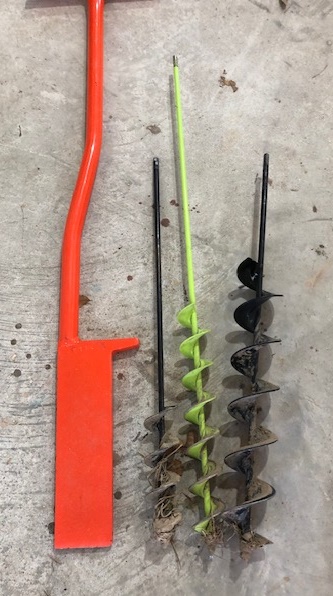
|
| End view of the two auger bits. They come in different diameters for different size root plugs. |
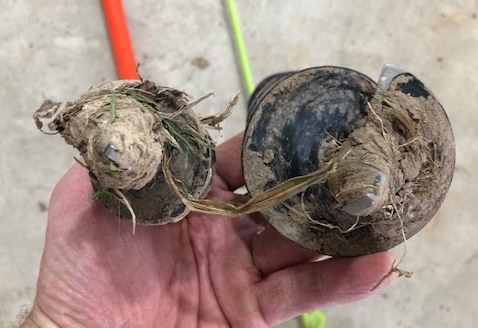
|
Find a location for the tree and mark with a flag.
There are a number of considerations on where to put a tree:
- Think about future access. You will need to water, mulch, clear competing plants, etc. So it is
helpful to place them where you can drive by on an ATV.
- Look at the soil.
Sand or clay? Dry or damp? Soft or hard?
- Sun exposure. Full sun? Can get hot and dry. Partial sun can shelter the new seedling, but growth may be stunted.
- Potential for insect and animal predation.
Each tree species has adapted to particular conditions. Do your best to research the tree and put it in a spot just right for it.
|
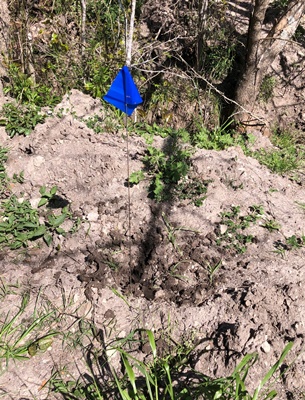
|
Drill a hole.
Try to get the hole depth just deep enough for about 1/4 inch of the seedling to stick up. |
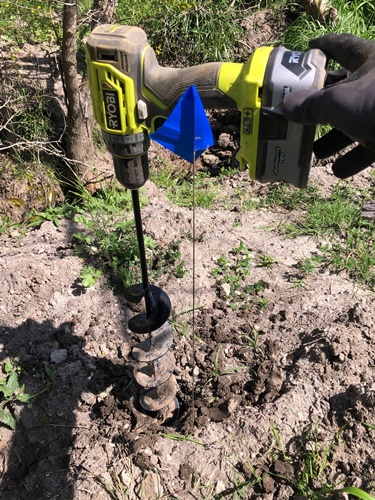
|
Select a tree.
"Right tree - right place - right time".
This is an important step - getting the right tree in the right place. Have a variety of trees on hand to pick from, and know what conditions they are adapted to. Full sun or shade, dry or damp, fast or slow growing. |
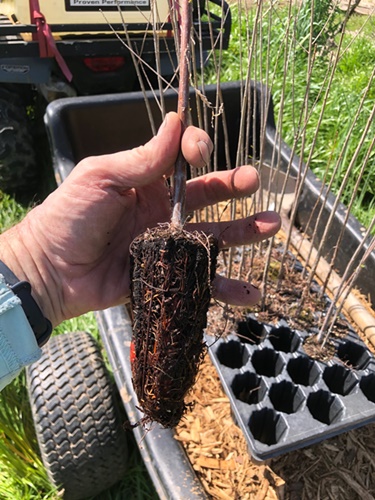
|
Slice the roots vertically in 3-4 places.
The seedling was grown in a container that constrained the roots from growing outward. That results in the roots being tightly bound vertically.
Slicing the roots vertically and gently pulling them out helps the roots get oriented in a horizontal direction.
|
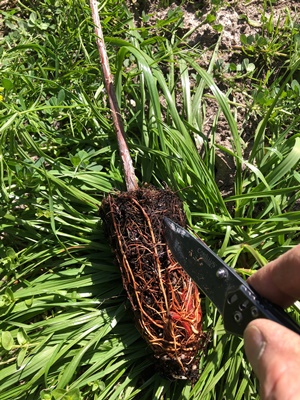
|
Put the tree in the hole, press the hole around the tree, move the flag close to the tree.
Trees breath - you want the top of the plug open to air. Also, you want the roots oriented outward and the main root not bent to the side. So push the seedling to the bottom of the hole to check depth, pull out and push dirt back in as needed to get the depth needed so the top of the seedling is about 1/4 inch above the ground. Put the seedling back in, push to the bottom and pull gently back up until the top of the seedling is just above the ground. Push the extra dirt into the hole, then use your fingers to mash the dirt firmy arond the seedling roots. Then move the flag close to the root - will make it easier to find the seedling in the future for watering, fertlizer, clearing, checking if healthy, etc. |

|
Fertlizer the tree.
This step is not something that is commonly recommended, but I like to think it is helpful. I put about 1/2 cup of fertlizer around the seedling. I use
MicroLife Mulit-Purpose 6-2-4. It is a slow release fertlizer with bacteria I hope will be introduced to the soil.
Unfortunately, the bacterial is likely not active and has perished from heat or dryness.
But it feels good applying it. Clear the top of the seedling so some air can get to the roots. |

|
Apply mulch.
I put two shovel scoops on each seedling. I use whatever mulch I can find - 800 trees take a lot of mulch! |
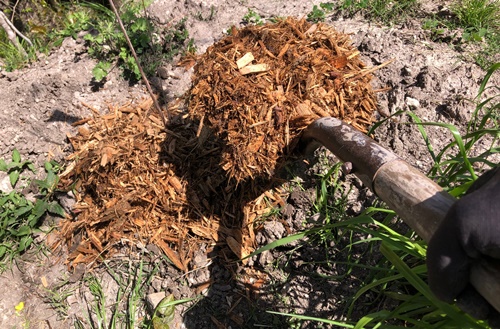
|
Shape the mulch.
The tree needs to breath at the top of the roots, so don't pile the mulch up around the trunk. Shape into a doughnut to better trap water. Note the top of the mulch can dry out and become hydrophobic,
preventing water from getting to the roots. A bowl shape helps capture water from rain or when watering. |
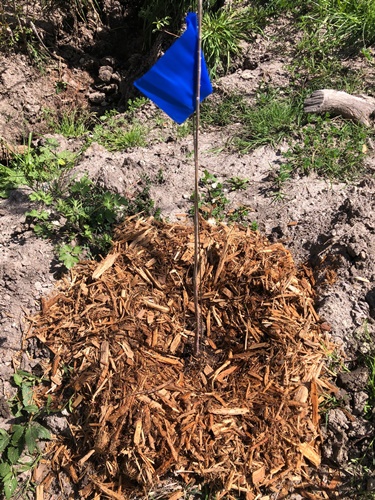
|
Water the tree.
Using the water tank on the back of the ATV, I give the newly planted seedling a good dousing of water.
My hope is to move any loose dirt into any voids around the seedling. Any roots that dry out will die and not contribute to the tree survival. |
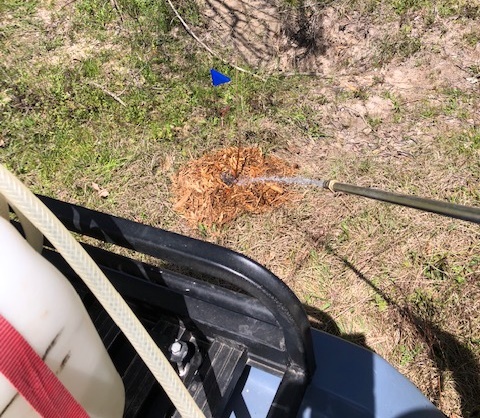
|
